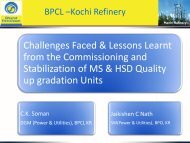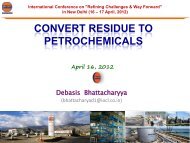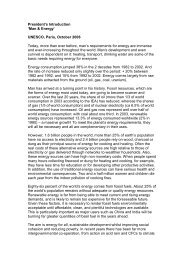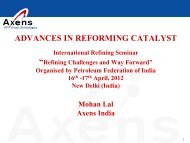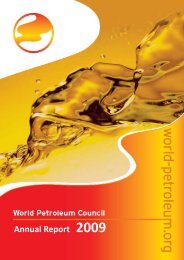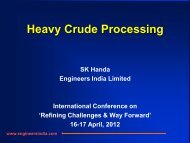pdf here - World Petroleum Council
pdf here - World Petroleum Council
pdf here - World Petroleum Council
Create successful ePaper yourself
Turn your PDF publications into a flip-book with our unique Google optimized e-Paper software.
Introduction to extraction, refining and processing<br />
Introduction to extraction, refining and processing<br />
Introduction<br />
to extraction,<br />
refining and<br />
processing<br />
By William Srite<br />
Oil, gas or coal can all be refined for the<br />
creation of petrochemical products.<br />
The importance of carbon chemistry<br />
Around the 1950s, carbon chemistry was dev eloped<br />
and we started using hydrocarbons in oil in new<br />
ways. While advances in new uses for hydro carbons<br />
occurred before the 1950s, such as the invention of<br />
Bakelite, the 1950s heralded a new and powerful era for<br />
the petrochemical ind us try. This continues to this day.<br />
Oil and gas were broken down into constituent<br />
parts and reassembled to make what we need. It<br />
was discovered that oil has every element needed<br />
to make any other organic compound. To do this,<br />
heat is used, certain catalysts and certain properties<br />
of physics will separate the elements and<br />
recombine them in more useful ways. It is similar<br />
to oil floating on water – that is a physical separation<br />
technique that can be applied to any two<br />
compounds that don’t mix.<br />
Mixing is related to the stability of atoms, electrons<br />
and valence shells and is outside the scope<br />
of this. But when two compounds are stabile (have<br />
the right number of electrons in their outer shell,<br />
usually eight, but it can vary and can be as many<br />
as 32) they don’t mix, then you can use physical<br />
sep aration techniques, like the one des cribed above.<br />
This allows us to make products as diverse as<br />
Kevlar, nylon, plastic, artificial sweeten ers, rubber<br />
tyres, and carbon fibre.<br />
The Sauber Mercedes C 291: The use of carbon-fibre reinforced plastic allowed the driver’s cell, safety bar and roof to be made in one<br />
piece for the first time.<br />
Substances such as ethylene, propylene, butadiene,<br />
benzene, toluene and xylenes are processed<br />
in petrochemical plants into more specialised<br />
products – and it can take more than one<br />
step for these products to become fit for use by<br />
downstream industries and then to be made into<br />
familiar products. For example, it takes one operation,<br />
albeit a complex one, to turn ethylene into<br />
plastic polyethylene but t<strong>here</strong> are more than seven<br />
steps involved in turning benzene into Nylon, one<br />
of the most commonly used materials in clothing<br />
and sporting equipment manufacturing.<br />
The science behind carbon chemistry<br />
Let’s step back for a moment and talk about<br />
physics and chemistry and how it works together.<br />
“Organic” chemistry can be explained as an “artificial”<br />
branch of chemistry that harkens back to a<br />
time when chemists were still trying to find the<br />
“essence of life” in elements – those that were<br />
thought to have this “essence” were organic<br />
elements and everything else was inorganic.<br />
Today, we know t<strong>here</strong> is no such thing as an<br />
“essence of life”, at least not in chemical elements.<br />
But, we still use the term and today it simply<br />
means chemistry or chemicals that use carbon as<br />
a building block. We’ve all heard that carbon is the<br />
building block of life and we’ll talk about why that<br />
is in a moment, but it is good to start with some<br />
basic science.<br />
First, we need to explain what an element is. An<br />
element is a substance made from just one kind of<br />
atom. Which is to say: you cannot reduce an<br />
element beyond the atomic level – you can, but<br />
particle physics is outside the scope of this. So, the<br />
element hydrogen is an atom made from one proton<br />
and one electron. It can also have a varying<br />
number of neutrons, as can all atoms. In an atom,<br />
a proton has a positive electric charge, a neutron<br />
has no charge at all and an electron is negatively<br />
charged. When t<strong>here</strong> is an imbalance in the charge,<br />
elements seek other elements to balance out.<br />
The 12 Pipestill Unit at BP’s Whiting oil refinery in Indiana.<br />
Currently undergoing modernisation, the refinery first started<br />
operation in 1889, predating the advent of the motor car.<br />
Carbon is such a useful element and is the basis<br />
of all life. This is because in its natural state it lacks<br />
four electrons in its outer shell, which makes it<br />
very, very promiscuous and willing to bond with<br />
almost any other element to try to fill that outer<br />
shell with four more electrons. That’s why we can<br />
string together long chains of hydrocarbons. Carbon<br />
has four different places w<strong>here</strong> we might attach<br />
another element, unlike, say helium, which has a<br />
full shell. Carbon is one of the most imbalanced<br />
elements in organic chemistry but, thanks to<br />
carbon chemistry, it continues to be one of the<br />
most useful, particularly in the field of petrochemical<br />
production.<br />
Refineries come in many different sizes and<br />
configurations, depending on the local market,<br />
the types of products required and the types of<br />
feedstocks available for processing. But all refiner-<br />
20 WPC Guide<br />
Petrochemicals and Refining 21



